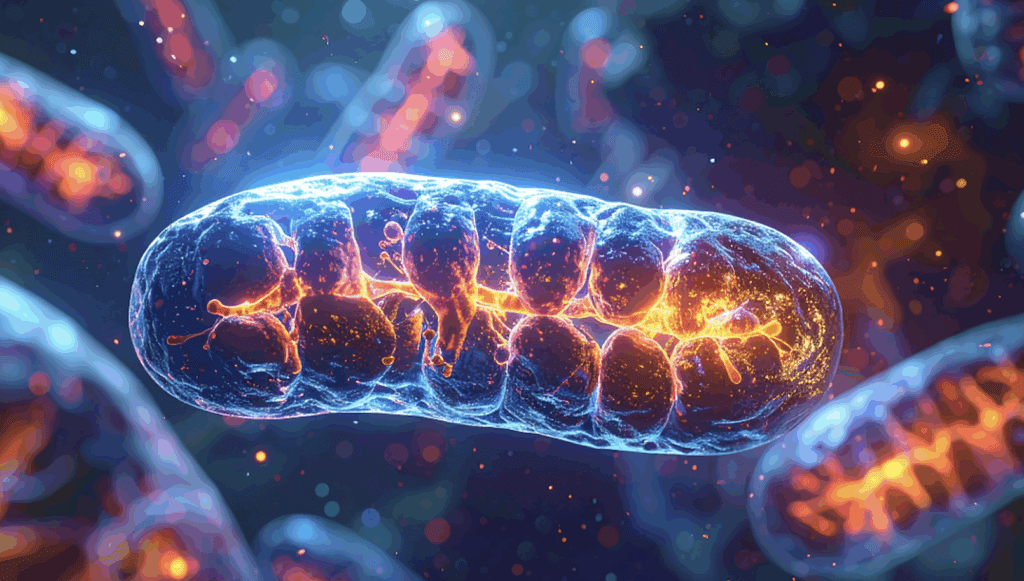
Everyone talks about energy, but where does it come from?
But what we call “energy”-the power to think, move, heal or create-does not come from food itself.
It comes from what the mitochondria can make of that food.
Food ≠ Energy
When we say “I eat for energy,” we are actually saying:
“I eat to provide raw material for my mitochondria.”
The body does not “burn” food like a flame in a stove: it oxidizes it in a controlled manner, releasing electrons that travel along the electron transport chain (ETC) within the mitochondria.
It is there, in that invisible dance of electrons and protons, that true biological energy is born: ATP (adenosine triphosphate).
How mitochondria produce energy
the universal language of life
Every time you eat, breathe or move, you are providing raw material to your mitochondria.
But fats, sugars, and proteins do not all enter through the same door: each macronutrient travels a different metabolic pathway before getting to the heart of the process.
- Carbohydrates are broken down in the cytoplasm by glycolysis, which generates small amounts of energy and produces pyruvate, which is then converted into acetyl-CoA.
- Fats are cleaved through β-oxidation, a pathway that removes two carbon atoms at a time from lipid chains, creating acetyl-CoA, the same key molecule derived from pyruvate.
- Amino acids can be converted into different intermediates flowing into the same circuit.
All these paths, different at first, converge at a common point: the Krebs cycle, or citric acid cycle.
The real purpose: to generate electrons
In the Krebs cycle, the goal is not so much to produce direct energy, but to Extract electrons from nutrients.
These electrons are collected by molecules-navets-NADH and FADH₂-that carry them to the electron transport chain (ETC), located on the inner membrane of the mitochondrion.
The transport chain: the electric circuit of life
Imagine the ETC as a series of stations passing these electrons from hand to hand, somewhat like a biological electrical cable.
Each time an electron passes from one station to another, it releases a small amount of energy.
This energy is used to pump hydrogen protons (H⁺) from inside the mitochondrion to the space between the two membranes (between the outer and inner membranes).
Thus a charge difference is created: positively charged protons outside the inner membrane, and negatively charged electrons inside it. A true biological battery.
When the protons return, they pass through an enzyme called ATP synthase, activating it. This enzyme transfers a phosphorus molecule to an ADP molecule, turning it into ATP-the universal energy currency of the cell.
It is the same principle as a dam: water (protons) rises, accumulating potential energy, and when it falls, it moves the turbine (ATP synthase) that generates electricity (ATP).
The universal language of nutrients
In the end, whether you ate fat, carbohydrates or protein doesn't change: all roads lead to electrons, and electrons lead to ATP.
A healthy organism with efficient mitochondria does not distinguish between energy sources: what matters is the quality of the “engine,” not the type of fuel.
If your mitochondria are working well, they can turn any nutrient, fat, sugar or amino acid into clean energy.
If they function poorly, even the most perfect food becomes just metabolic dead weight.
A Ferrari with a perfectly good engine can run even if you put in other than ideal gasoline (at least as long as you don't constantly use the wrong fuel), but if the engine is dirty, damaged or oxidized, no matter how pure the fuel is, it still won't start.
Similarly, a body with healthy mitochondria can use both fats and sugars with equal efficiency, while a metabolically compromised body wastes both, accumulating waste and fatigue.
Not everything we eat becomes ATP
And here is the key point: Energy yield is not the same for all nutrients, Nor for all people.
What matters is not just how much you eat, but how well your mitochondria can turn it into real energy.
- Fats: produce more ATP per molecule, but require more oxygen and fully efficient mitochondria. When mitochondrial function is high, fat oxidation is the cleanest and most stable way to generate energy.
- Sugars: they provide quick energy, useful under conditions of exertion or urgency, but less sustainable over the long term. However, if the mitochondria fail to oxidize them completely, the pyruvate derived from glycolysis is diverted to lactate production (an “emergency” form of energy). If there is an energy surplus, some of the sugars may be converted to fat (de novo lipogenesis) instead of being used to generate ATP.
- Amino acids: contribute only part of the energy production-the rest is for tissue construction and repair, enzymes and hormones.
Food, therefore, provides potential energy, not real energy.
Your mitochondrial efficiency makes the difference.
When mitochondria slow down
Dysfunctional mitochondria = low energy, even if you eat well.
It happens when:
- there is oxidative stress Chronic (too many free radicals not balanced by antioxidants)
- lacks oxygen or movement (less blood flow, less cellular respiration)
- there is systemic inflammation (which damages mitochondrial membranes)
- micronutrients are lacking Key: magnesium, CoQ10, iron, riboflavin, niacin
Under these conditions, the body “sees” the food but cannot use it.
It is like a car with a full tank of gas but a broken engine.
How to reactivate bioenergy
Mitochondria Do not need extreme stimulation: need contrast, movement, light, breath.
Here are some simple but powerful strategies:
- Morning sunlight: synchronizes circadian rhythm and enhances mitochondrial activity.
- Controlled cold: stimulates mitochondrial biogenesis (creation of new mitochondria).
- Regular exercise: induces mitophagy (renewal of old and dysfunctional mitochondria).
- Deep breathing and oxygenation: optimizes the proton gradient for ATP production.
- Diet rich in real nutrients: CoQ10, carnitine, medium-chain fatty acids, and essential minerals are direct cofactors of the respiratory chain.
Anything that is “good for you”-sleeping, moving, eating clean, being in the light, breathing better-is good for you because it regenerates the mitochondria.
Example of key nutrients for mitochondrial function
B vitamins: the carburetors of bioenergy
B vitamins act at every stage of energy production:
- B1 (thiamine)-essential for glucose entry into the mitochondria (Krebs cycle).
- B2 (riboflavin)-precursor of FAD and FMN, molecules that carry electrons in the respiratory chain.
- B3 (niacin)-from which NAD⁺, the main electron carrier, is derived: without NAD⁺, no ATP.
- B5 (pantothenic acid)-serves to form coenzyme A, which is essential for the oxidation of fats and sugars.
- B6, B9, B12 - regulate homocysteine metabolism and neurotransmitter synthesis, supporting the brain and nervous system.
A balanced B complex helps keep all these steps active, sustaining mental and physical energy naturally.
Magnesium: the key that turns on ATP
Each ATP molecule, to be “active,” must bind to a magnesium atom. Without magnesium, ATP remains chemically inert.
In addition, magnesium:
- stabilizes mitochondrial membranes
- regulates the flow of intracellular calcium
- Reduces inflammation and oxidative stress
Deficient in much of the modern population, it is one of the most important minerals for supporting cellular energy and nerve recovery.
Selenium: the antioxidant shield of mitochondria
Selenium is an essential trace element involved in the synthesis of selenoproteins-including glutathione peroxidase (GPx) and thioredoxin reductase.
These enzymes represent the mitochondria's main line of defense against free radicals (ROS) produced during cellular respiration.
When selenium is deficient:
- the ROS accumulate,
- the mitochondrial membranes Are damaged,
- and drops the efficiency of the respiratory chain.
Conversely, a good level of selenium helps preserve mitochondrial integrity, supporting cellular longevity, fertility, and immunity.
Therefore, selenium does not “energize” directly, but protects energy plants from oxidative attrition - A key factor in keeping mitochondria viable over time.
In summary:
Mitochondria feed not only on fats and sugars, but on vitamins and minerals that keep them alive.
A good intake of B-complex, magnesium, and selenium does not “give energy” in the stimulant sense of the word: it restores its biological capacity by acting where energy originates, in the mitochondria.
Want suggestions about which supplements to choose?
I use these:
CLICK HERE!


Thank you for the competence, accuracy and clarity in ’exposition. 🙏
Good morning Doctor I am 51 years old in menopause. In June I was diagnosed with diverticulosis.I started to diet by eliminating all processed foods and with a higher protein intake .I have lost 4 kg and am much better. I am deficient in vitamin B12 and every time I take magnesium this causes me dysentery. The hematologist advised me to do cycles of bvital every 3 months. I would like to know from her how to supplement ,also I have joined a gym. Since following your advice I have been reborn. Thank you and have a good day.
Thank you very much, I find this uplifting.
Beautiful article! 💫 Clearly explained and motivating. Mitochondria are really the heart of our life energy! 🔋✨
I am 68 years old and have never been as well in my life as I am now; as a child and up to 10 years ago I suffered from intestinal worms, seen in the feces moving around. I had a persistent cough that diminished in warm weather; no medication worked. For more than 3 years I have not eaten processed foods bread, pasta, pizzas, etc. My life has changed completely I feel energetic, active even mentally ; at home I have two flights of stairs that if I want I can run them several times . The cough of course is a distant memory, I have lowered my blood pressure by about 10 points, the headache I don't know what it is anymore, I don't use lip labellum anymore, I don't use laxatives anymore, I have mucous membranes in my nose like a baby without the annoying bleeding capillaries, I have lost 4 kg. I think a better effect could not be achieved, the whole thing I started it just to try to verify one of the many theories you hear about ’nutrition. Sincerely.
Very interesting and clear article. Congratulations.
Thanks..... another very clear and understandable biology lesson I would be interested to know how much life mina b12 we need to have in our blood and why we are concerned if excessive. Thanks again!!!
Thank you Oliver!!! Your scientific explanations allow me a more informed .
Thank you
Good morning Dr. Tomasi, thank you for sending me this information,I am afraid to take the supplements because I am allergic to nickel and histamine.
Excellent description
Great !!! Thank you
Danke für die ausführliche und verständliche Erklärung!
Bravooo, comprehensive, simple in describing biochemical processes to understand how our metabolism works.
Thank you
Thank you Oliver for this very valuable information of yours. I have created a binder , print everything out and every now and then reread them so I don't forget how valuable this information is.
Simple and clear description as always . Thank you for this valuable information
Way to go Oliver!
Like Mom, you can explain complex topics in a simple way.
You are a wonderful family!
Manuela